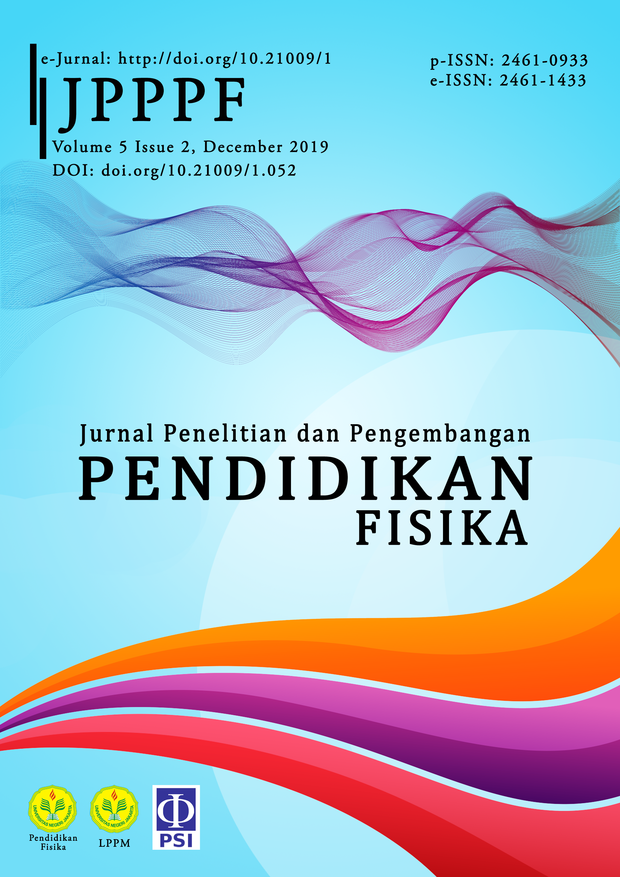Student Cognitive Profile with STEM Based Teaching Material on the Subject of Vibrations and Waves
DOI:
https://doi.org/10.21009/1.05217Keywords:
teaching material, STEM, cognitive profile, vibration, waveAbstract
The results of study Trends in International Mathematics and Science Study (TIMSS) 2011 at the secondary school level showed that the achievement of learning outcomes of Indonesian students in the fields of mathematics and science had not shown satisfactory results. One way to implement effective and enjoyable learning can be supported by teaching materials used in learning. Teaching materials are one of the supporting factors for student learning success. This study aims to produce products and apply teaching materials based on Science, Technology, Engineering, and Mathematics (STEM) to determine the profile of the cognitive process of understanding the concepts of vocational students. The method used in this study is research and development. Characteristics of STEM-based teaching materials that contain material about vibrations and waves associated with STEM aspects and equipped with problems and practical procedures. The results of the analysis of teaching materials can be categorized as feasible, with a percentage of 78.46%. The results of the analysis of student responses after the application of the teaching materials were obtained with a percentage of 83.74% so that it can be concluded that the teaching material included in the category is very practical to use. The results of the cognitive profile analysis of students' understanding of concepts obtained an interpretation percentage of 76.06%; exemplifying 84.44%; inference 67.78%; comparing 62.59%; explain 59.89%.
References
Ames, T., Reeve, E., Stewardson, G., & Lott, K 2017, ‘Wanted for 21st Century Schools: Renaissance STEM Teacher Preferred’, Journal of Technology Education, vol. 28, no. 2, pp. 19-30.
Arikunto, S 2013, ‘Dasar-Dasar Evaluasi Pendidikan Edisi 2’, Jakarta, Bumi Aksara.
Basyari, N 2015, ‘Penerapan Levels of Inquiry pada Tingkat Interactive Demonstrasion untuk Meningkatkan Pemahaman Konsep Pesawat Sederhana pada Siswa SMP’, Skripsi, Universitas Pendidikan Indonesia.
Becker, K., & Park, K 2011, ‘Effects of Integrative Approaches Among Science, Technology, Engineering, and Mathematics (STEM) Subjects on Students’ Learning: A Preliminary Meta-Analysis’, Journal of STEM Education, vol. 12, no. 5-6, pp. 23-37.
Cahyati, C 2015, ‘Penerapan Model Pembelajaran Problem Solving untuk Meningkatkan Pemahaman Konsep Siswa pada Materi Energi’, Skripsi, Universitas Pendidikan Indonesia.
Copeland, S., Furlong, M., & Boroson, B 2018, ‘A STE[A]M Approach to Teaching and Learning’, International Journal of Teaching and Learning in Higher Education, vol. 30, no. 3, pp. 534-548.
Ejiwale, J 2013, ‘Barriers to Successful Implementattion of STEM Education’, Journal of Education and Learning, vol. 7, no. 2, pp. 67-74.
Hapiziah, S., Suhery, T., & Mujamil, J 2015, ‘Effects of Integrative Approaches Among Science, Technology, Engineering, and Mathematics (STEM) Subjects on Students’ Learning: A Preliminary Meta-Analysis’, Journal of STEM Education, vol. 12, no. 5-6, pp. 23-37.
Murthi’ik, I. I., Abdurrahman., & Rosidin, U 2018, ‘The Effectiveness of Applying STEM Approach to Self-Efficacy and Student Learning Outcomes for Teaching Newton’s Law’, Jurnal Penelitian dan Pengembangan Pendidikan Fisika, vol. 4, no. 1, pp. 11-18.
Pangesti, K. I., Yulianti, D., & Sugianto 2017, ‘Bahan Ajar Berbasis STEM (Science, Technology, Engineering, and Mathematics) untuk Meningkatkan Penguasaan Konsep Siswa SMA’, Unnes Physics Education Journal, vol. 6, no. 3, pp. 53-58.
Peraturan Pemerintah Republik Indonesia Nomor 19 Tahun 2005.
Riduwan, 2009, ‘Belajar Mudah Penelitian untuk Guru Karyawan dan Peneliti Pemula’, Bandung: Alfabeta.
Sari, D. S 2015, ‘Pengembangan Bahan Aajar Fisika Berbasis Experiental Learning dalam Meningkatkan Pemahman Konsep dan Minds-on Siswa’, Skripsi, FMIPA Universitas Negeri Semarang.
Satriawan, M., & Rosmiati 2016, ‘Pengembangan Bahan Ajar Fisika Berbasis Kontestual dengan Mengintegrasikan Kearifan Lokal untuk Meningkatkan Pemahaman Konsep Siswa pada Mahasiswa’, Jurnal Penelitian Pendidikan Sains, vol. 6, no. 1, pp. 1212-1217.
Siew, N. M., Amir, N., & Chong, C. L 2015, ‘The Perceptions of Pre-Service and In-Service Teachers Regarding a Project-Based STEM Approach to Teaching Science’, A Springer Open Journal, vol. 4, no. 8, pp. 1-20.
Taqiyyah, S. A., Subali, B & Handayani, L 2017, ‘Implementasi Bahan Ajar Sains Berbahasa Inggris berbasis Metakognitif untuk Meningkatkan Kemampuan Pemecahan Masalah Siswa SMP’, Jurnal Inovasi Pendidikan IPA, vol. 3, no. 2, pp. 224-234.
Thibaut, L., Ceuppens, S., Loof, H. D., Meester, J. D., Goovaerts, L., Struyf, A., Pauw, J. B., Dehaene, W., Deprez, J., Cock, M. D., Hellinckx, L., Knipprath, H., Langie, G., Struyven, K., Velde, D. V., Petegem, P. V., & Depaepe, F 2018, ‘Integrated STEM Education: A Systematic Review of Instructional Practices in Secondary Education’, European Journal of STEM Education, vol. 3, no. 1, pp. 1-12.
Utami, I. S., Septiyanto, R. F., Wibowo, F. C., & Suryana, A 2017, ‘Pengembangan STEM-A (Science, Technology, Engineering, Mathematic and Animation) Berbasis Kearifan Lokal dalam Pembelajaran Fisika’, Jurnal Ilmiah Pendidikan Fisika Al-BiRuNi, vol. 6, no. 1, pp. 67-73.
Zaniewski, A. M., & Reinholz, D 2016, ‘Increasing STEM Success: A Near-Peer Mentoring Program in the Physical Sciences’, International Journal of STEM Education, vol. 3, no. 14, pp. 1-12.











